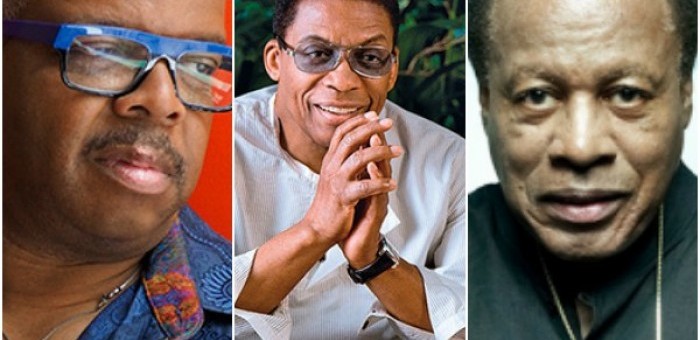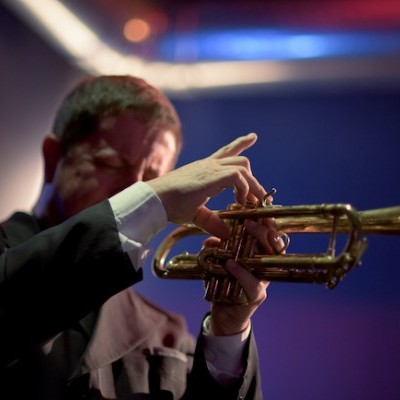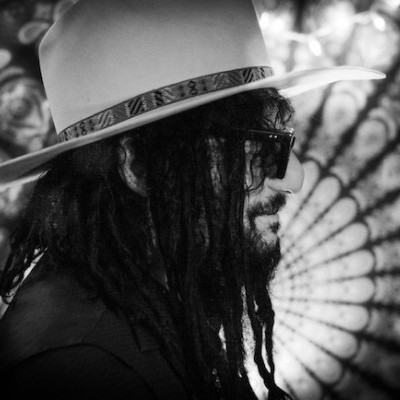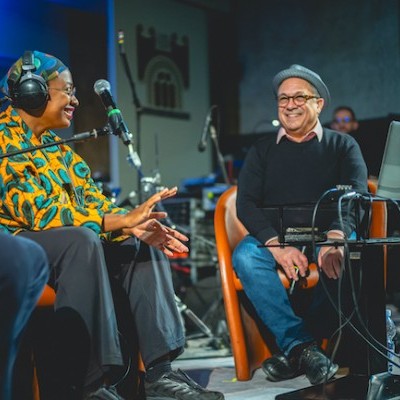Jul 9, 2024 11:35 AM
Trumpeter, Educator Jim Rotondi Dies at 61
Jim Rotondi, a renowned hard-bop trumpeter, composer and educator, died suddenly on July 7 at a hospital in France. He…

Terence Blanchard, Herbie Hancock, Wayne Shorter performed together at Disney Hall in Los Angeles on Feb. 19.
(Photo: Courtesy of the artists )Los Angeles is very lucky to count pianist Herbie Hancock and saxophonist Wayne Shorter as residents. Both are American jazz treasures, and whenever they want to descend from the hills to impart some knowledge, it is always welcome. But Hancock’s tenure as the Creative Jazz Chair at the Los Angeles Philharmonic has been marred by frequent disappointments, including bookings of fringe jazz acts (John Fogerty, Steve Winwood) and overreaching lineups that rarely equal the sum of their parts.
On Feb. 19 Hancock continued that tradition, overloading the stage with more than 100 members of the Los Angeles Philharmonic to provide pleasant accompaniment to a band that also included trumpeter Terence Blanchard, bassist James Genus and drummer Vinnie Colaiuta. If only the quintet had split the purse and the let the orchestra enjoy a three-day weekend at home, real magic could have been made.
Brooklyn 12-piece Snarky Puppy opened the show. Ordinarily, they are the largest band on the bill, but at Disney Hall they were subsumed by the cavernous venue—there were 10 empty chairs on for every member of the band. A technically precise ensemble, the Snarky Puppy crew is sloppy sartorially. (Many of the teenagers who filled the seats of the high-priced house were more formally dressed than the band.)
They started off slow and quiet but three electric guitars can’t stay quiet forever. “Semente,” from their recent release Culcha Vulcha (GroundUp), turned that around with a playful introduction by bandleader and bassist Michael League. The band was a blur of keyboards propelled by the ebullient rhythmic duo of Nate Werth on percussion and Robert “Sput” Searight on drums.
Songwriter David Crosby was in the audience, their loudest cheerleader, hooting with each blast of horns. As rigidly precise as the band can feel at times, they were certainly doing their part to loosen up the audience. The heat of the evening never got any higher.
Last summer, as part of the Hollywood Bowl’s jazz series, Carlos Santana assembled Mega Nova, a jazz-rock supergroup that not only included Hancock and Shorter but also bassist Marcus Miller and drummer Cindy Blackman-Santana. They played one gig. It was a rudderless drift from one idea to another that saw the ensemble unexpectedly covering both Cyndi Lauper and the National Anthem. Their powers combined did not eclipse each other’s talent.
Hancock and Shorter’s collaboration on Feb. 19 was an even more ambitious swing at grandiosity—with a result that was equally short of transcendent.
The headliners filled the front of the stage; the orchestra filled out the chairs behind them. There were more people on stage than most jazz clubs have capacity. Hancock said a few words about the first tune, Terence Blanchard’s arrangement of a Hancock solo performance, and then off went the house lights.
That tune, called “Herbie Hancock By Himself”, featured mostly the orchestra. Blanchard is a fantastic composer for the screen. His work greatly enhances visual imagery, but onstage, things seemed a little lost. Lush ideas floated by but didn’t stick. In the spaces where a solo voice could step in, it was rare that anyone took a stab with Blanchard playing the most, Hancock tapping out a few ideas and Shorter playing the least.
Shorter, a jazz talisman whose mere presence on the stage is enough to merit a standing ovation, was clearly not being paid by the note. He sat center stage along a baffle against the piano, head down, checking the music, occasionally blowing into his soprano and tenor saxophone.
On a drawn out “Footprints” that had the orchestra tumbling about in booming splashes, Blanchard thundered through a spirited solo. Shorter then took the spotlight on soprano, sat up, began to poke around the bass riff and abruptly stopped less than two choruses into the blues. The audience leaned in with miraculous attention (as they always do for Shorter in Los Angeles) and then exhaled. If he was going to bite, this wasn’t the forkful.
The sleepy set must have been a dream come true for Blanchard. To have one of the most respected orchestras in the world playing your arrangements is quite the accomplishment. Unfortunately, those less invested in the music seemed to drift off.
The assembled musicians also tackled Hancock’s “Maiden Voyage,” but no amount of glockenspiel, gongs and timpani drums could have improved on what the core quintet could have done with the tune. In lieu of in-depth solos and engaging musical interactions,the audience was treated to a lot of swelling strings, warm brass and furtive looks. When he was briefly allowed to stretch out, Genus proved that he had enough strength and vitality on four strings to match the anonymous group of highly-paid orchestra members sitting behind him.
Hancock and Shorter are such brilliantly intimate musicians. When they bounce off of each other, it is a language of whispers and telepathy; but when they only play for crowds of thousands, it’s hard to capture that spirit. On this night, the band never really got into that pocket, instead trying to blend in with an orchestra rather than control it.
A little over an hour after starting, the houselights came up and nobody looked sure if they could leave yet. Should they play another tune? Could they just count one off and bring a little intimacy and spontaneity to the night? They could have, but they didn’t. Hancock thanked the crowd, the band stood up and everybody left the stage. That was all, folks. DB

Jim Rotondi was acclaimed for his wide, round trumpet tone, remarkable virtuosity and assured swing.
Jul 9, 2024 11:35 AM
Jim Rotondi, a renowned hard-bop trumpeter, composer and educator, died suddenly on July 7 at a hospital in France. He…

Charles Lloyd, seen here at the 2024 New Orleans Jazz & Heritage Festival, makes DownBeat Poll history!
Jul 11, 2024 12:23 PM
The incomparable Charles Lloyd swept the 72nd Annual DownBeat Critics Poll, becoming the first artist ever to earn…

“Being president of Blue Note has been one of the coolest things that ever happened to me,” Was said. “It’s a gas to serve as one of the caretakers of that legacy.”
Jun 4, 2024 12:21 PM
Sitting with Don Was is a comfortable and unhurried exercise. He may seem slightly reserved at first, but ideas and…

“She reminds me of my childhood and makes we want to cry,” Cécile McLorin Salvant, pictured here with writer Ashley Kahn, said of Dianne Reeves.
Jun 11, 2024 12:31 PM
Italy’s Umbria Jazz Winter is one of those rare annual festivals that not only coincides with a major holiday —…

Maria Schneider said of Decades, her new compilation release: “I just wanted to create something, put it in a beautiful box and say, ‘Look at what we did.‘”
Jun 18, 2024 12:00 PM
Maria Schneider opened the sleek black box and placed it on a coffee table in her Manhattan apartment. Inside lay the…